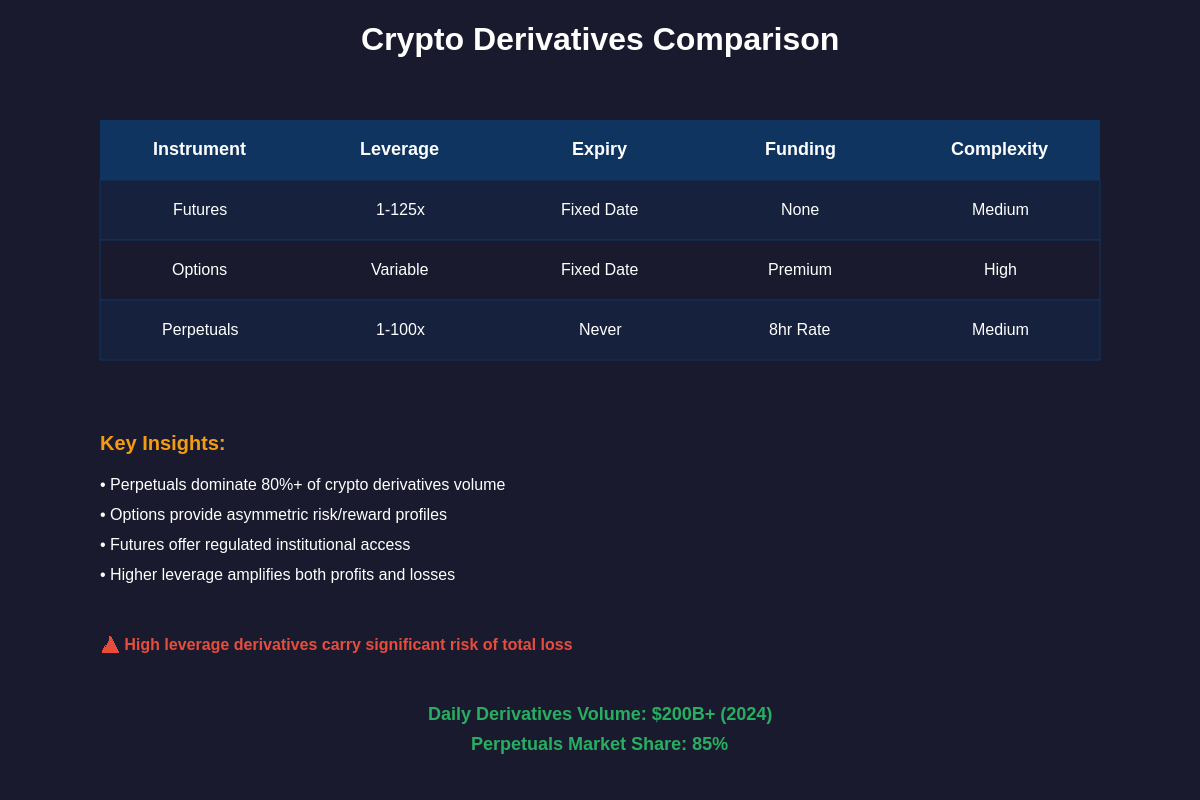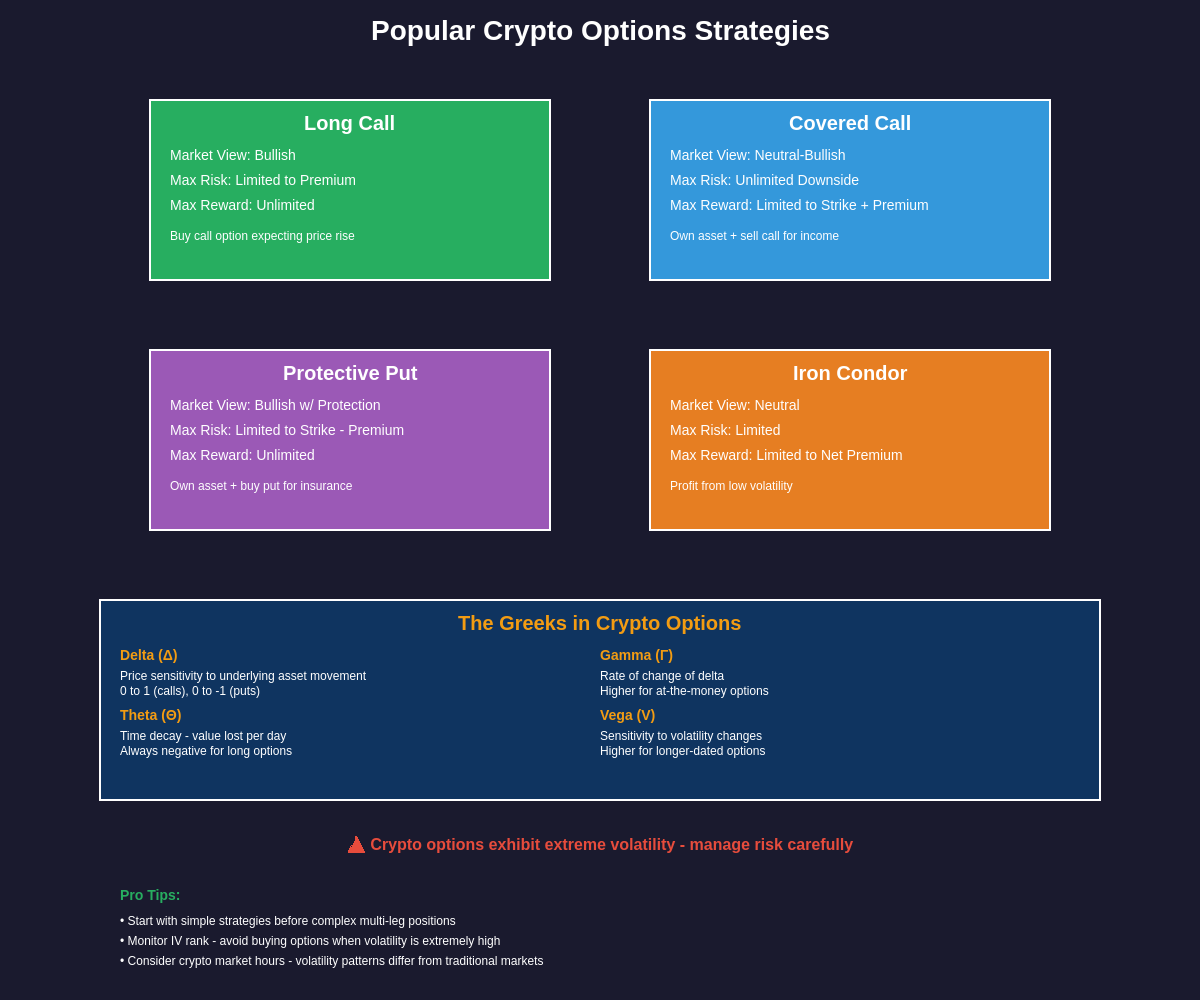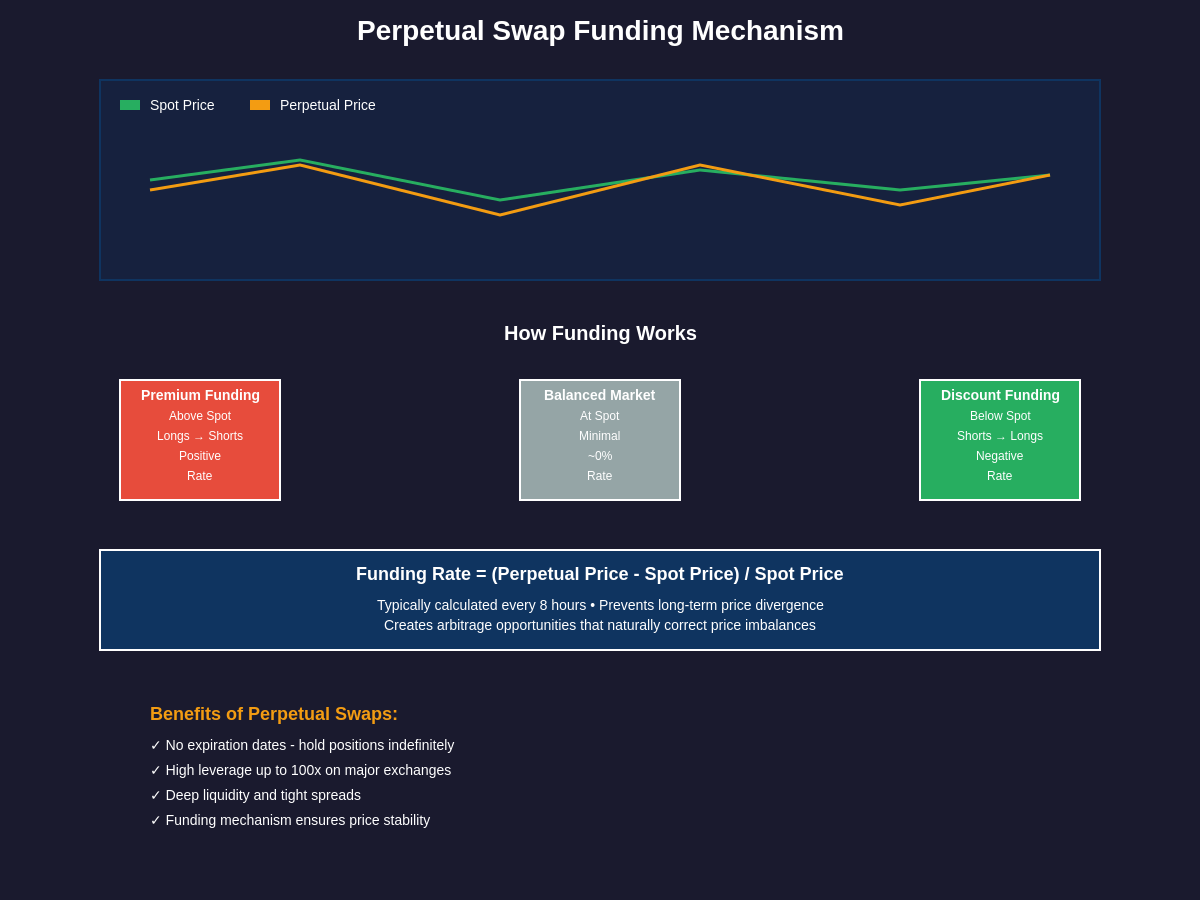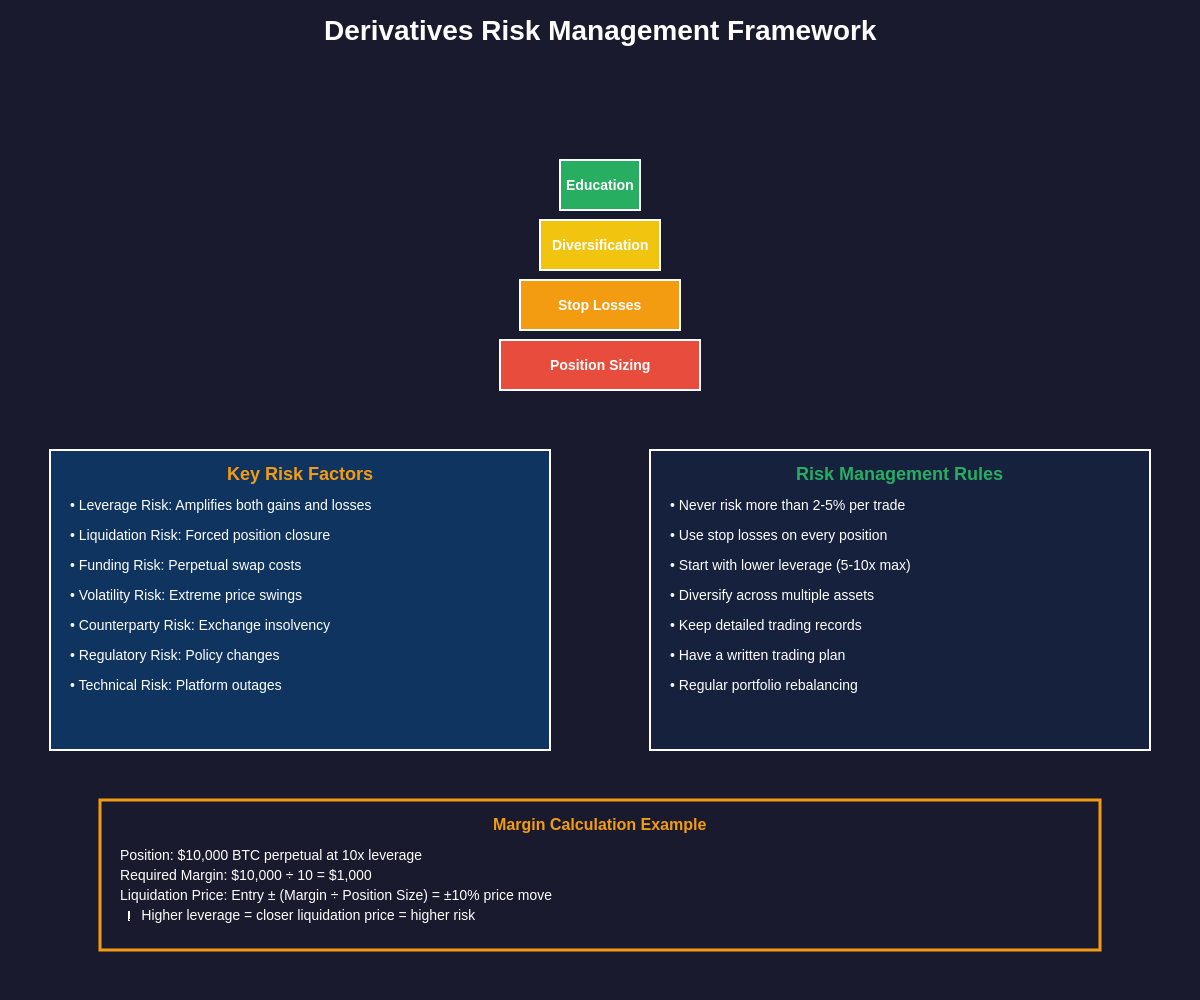The cryptocurrency derivatives market has emerged as one of the most dynamic and rapidly growing segments of the digital asset ecosystem, with trading volumes regularly exceeding those of spot markets and sophisticated financial instruments providing traders with unprecedented opportunities for risk management, speculation, and portfolio optimization. Understanding the fundamental mechanics, strategic applications, and risk characteristics of crypto derivatives including futures contracts, options, and perpetual swaps has become essential for any serious participant in modern cryptocurrency markets, whether institutional investor, professional trader, or sophisticated retail participant seeking to navigate the complex landscape of digital asset financial products.
Trade crypto derivatives with advanced tools on TradingView
The explosive growth of cryptocurrency derivatives trading represents a maturation of digital asset markets, transforming them from simple spot trading venues into sophisticated financial ecosystems capable of supporting complex trading strategies, risk management techniques, and institutional-grade investment products. This evolution has been driven by increasing institutional adoption, regulatory clarity in key jurisdictions, technological innovations in trading infrastructure, and growing demand for sophisticated financial tools that can accommodate the unique characteristics of highly volatile cryptocurrency markets.
The Evolution of Cryptocurrency Derivatives Markets
The development of cryptocurrency derivatives markets has followed a trajectory that mirrors the broader evolution of digital asset trading, beginning with simple Bitcoin futures contracts on traditional exchanges and evolving into a comprehensive ecosystem of sophisticated financial instruments traded on specialized cryptocurrency platforms with advanced features designed specifically for digital asset characteristics. The first cryptocurrency futures contracts were introduced by established financial institutions seeking to provide regulated exposure to Bitcoin price movements, but the real innovation occurred when cryptocurrency-native platforms began developing derivatives products specifically tailored to the unique needs of digital asset traders.
Traditional financial derivatives markets provided the conceptual foundation for cryptocurrency derivatives, but the unique characteristics of digital assets including extreme volatility, twenty-four-hour trading cycles, cross-border accessibility, and the absence of traditional settlement infrastructure required significant innovations in contract design, risk management, and operational procedures. Early cryptocurrency derivatives platforms faced numerous challenges including regulatory uncertainty, technological limitations, liquidity constraints, and the need to develop entirely new approaches to margin management and settlement in markets that never close.
The introduction of perpetual swap contracts represented a particularly significant innovation in cryptocurrency derivatives design, offering traders the benefits of futures contracts without traditional expiration dates while incorporating innovative funding mechanisms designed to keep contract prices closely aligned with underlying spot markets. This innovation addressed one of the key limitations of traditional futures contracts in highly volatile markets, where periodic settlement and contract rollover created operational complexity and potential price dislocations that could be exploited by sophisticated traders.
Cross-margining capabilities and portfolio-based risk management systems developed by leading cryptocurrency derivatives platforms have enabled more efficient capital utilization and sophisticated trading strategies than were possible with traditional derivatives products, allowing traders to manage complex multi-asset positions with reduced collateral requirements while maintaining appropriate risk controls. These innovations have been particularly important for institutional participants who require sophisticated risk management tools and capital efficiency to justify participation in cryptocurrency markets.
Futures Contracts in Cryptocurrency Markets

Cryptocurrency futures contracts represent agreements to buy or sell a specific digital asset at a predetermined price on a specified future date, providing market participants with standardized instruments for price discovery, risk management, and speculative trading while offering the familiar structure of traditional commodity futures adapted for the unique characteristics of digital asset markets. These contracts have become fundamental building blocks of the cryptocurrency derivatives ecosystem, enabling sophisticated trading strategies and providing institutional investors with regulated access to cryptocurrency price exposure.
The mechanics of cryptocurrency futures trading involve the same basic principles as traditional commodity futures, with buyers and sellers entering into standardized contracts that specify the underlying asset, contract size, delivery date, and settlement terms, though cryptocurrency futures often incorporate unique features such as cash settlement in stablecoins or Bitcoin rather than fiat currencies, and settlement procedures designed to accommodate the digital nature of the underlying assets. Most cryptocurrency futures contracts are cash-settled rather than requiring physical delivery of the underlying digital assets, which simplifies settlement procedures and reduces operational complexity while still providing effective price exposure.
Bitcoin futures contracts were among the first cryptocurrency derivatives to gain mainstream acceptance, initially launched on traditional derivatives exchanges such as the Chicago Mercantile Exchange and later expanded to include a wide variety of alternative cryptocurrencies and specialized contract structures designed for different trading strategies and risk profiles. The success of Bitcoin futures demonstrated the viability of cryptocurrency derivatives and paved the way for more sophisticated products including options, swaps, and structured products that have significantly expanded the range of available trading strategies.
Analyze Bitcoin futures prices with professional charts
Price discovery mechanisms in cryptocurrency futures markets play a crucial role in overall market efficiency, with futures prices often leading spot prices during periods of high volatility or significant market events, reflecting the concentrated liquidity and sophisticated participants that characterize derivatives markets. The relationship between futures and spot prices, known as the basis, provides important information about market sentiment, funding costs, and supply and demand dynamics that can be valuable for both traders and fundamental analysts seeking to understand cryptocurrency market conditions.
Leverage capabilities in cryptocurrency futures trading typically exceed those available in traditional financial markets, with some platforms offering leverage ratios of fifty-to-one or higher, though such high leverage levels require sophisticated risk management techniques and are generally recommended only for experienced traders who fully understand the potential for both profits and losses. The availability of high leverage has contributed to the popularity of cryptocurrency futures among active traders, but it has also created concerns about market stability and the potential for cascading liquidations during periods of extreme volatility.
Options Trading in Digital Asset Markets
Cryptocurrency options contracts provide traders with the right, but not the obligation, to buy or sell digital assets at specified prices within predetermined time periods, offering more flexible risk management and profit potential than linear instruments like futures while enabling sophisticated strategies that can profit from various market conditions including volatility, time decay, and directional price movements. The options market for cryptocurrencies has grown significantly as platforms have developed sophisticated pricing models and risk management systems capable of handling the extreme volatility characteristics of digital asset markets.
The fundamental mechanics of cryptocurrency options trading mirror those of traditional options markets, with call options providing the right to buy assets at strike prices and put options providing the right to sell, though cryptocurrency options often incorporate unique features such as settlement in various digital assets, American-style exercise capabilities, and pricing models adapted for the high volatility environment of cryptocurrency markets. European-style options, which can only be exercised at expiration, are also common in cryptocurrency markets and offer advantages for certain trading strategies and risk management applications.

Volatility trading represents one of the most sophisticated applications of cryptocurrency options, as the extreme price swings characteristic of digital asset markets create significant opportunities for traders who can accurately forecast and trade volatility levels rather than directional price movements. Professional options traders often focus on implied volatility levels, using sophisticated models to identify mispriced options and construct positions that can profit from volatility expansion or contraction regardless of the underlying asset’s price direction.
Options strategies in cryptocurrency markets range from simple directional bets using call or put options to complex multi-leg strategies such as straddles, strangles, butterflies, and iron condors that can profit from specific combinations of price movement, volatility changes, and time decay. These strategies require sophisticated understanding of options pricing theory and risk management, but they offer traders unprecedented flexibility in expressing market views and managing portfolio risk in ways that are impossible with spot or futures positions alone.
The Greeks, including delta, gamma, theta, and vega, play crucial roles in cryptocurrency options trading and risk management, helping traders understand how option values will change in response to various market factors and enabling sophisticated hedging strategies that can protect portfolios against specific types of risk while maintaining exposure to desired market movements. Understanding and managing the Greeks becomes particularly important in cryptocurrency markets due to the extreme volatility and rapid price changes that can dramatically affect option values over short time periods.
Perpetual Swap Contracts and Funding Mechanisms

Perpetual swap contracts represent one of the most innovative and popular cryptocurrency derivatives instruments, combining the leverage and flexibility of futures contracts with the convenience of never-expiring positions, while incorporating sophisticated funding mechanisms designed to keep contract prices aligned with underlying spot markets without requiring periodic settlement or contract rollover procedures. These instruments have become the backbone of cryptocurrency derivatives trading, offering traders continuous exposure to price movements with embedded mechanisms that ensure price stability and market efficiency.
The funding mechanism that defines perpetual swap contracts involves periodic payments between long and short position holders, with the direction and magnitude of these payments determined by the relationship between the perpetual contract price and the underlying spot price, creating economic incentives that naturally drive convergence between derivative and spot prices. When the perpetual contract trades at a premium to spot prices, long position holders pay funding to short position holders, creating incentives for arbitrageurs to sell perpetuals and buy spot assets, which naturally brings prices back into alignment.
These funding rates typically adjust every eight hours on most platforms and are calculated based on the difference between the perpetual contract price and a reference spot price, along with an interest rate component that reflects the cost of holding the underlying asset. The funding rate mechanism creates a self-balancing system that maintains price stability without requiring the complex rollover procedures and potential price gaps associated with traditional futures contracts, making perpetual swaps particularly attractive for traders who want to maintain long-term positions without worrying about contract expiration dates.
Track perpetual swap funding rates across exchanges
Advanced features of perpetual swap contracts include cross-margining capabilities that allow traders to use multiple assets as collateral, portfolio-based risk management systems that calculate margin requirements across all positions rather than on an individual contract basis, and sophisticated liquidation mechanisms designed to minimize market impact while protecting the exchange and other traders from default risk. These features have made perpetual swaps particularly popular among institutional traders who require efficient capital utilization and sophisticated risk management capabilities.
The leverage capabilities of perpetual swap contracts often exceed those of traditional futures contracts, with some platforms offering leverage ratios exceeding one hundred to one, though such extreme leverage levels require exceptional risk management discipline and are typically used only by very experienced traders who understand the potential for rapid and complete loss of capital. The combination of high leverage and continuous trading creates opportunities for significant profits but also substantial risks that must be carefully managed through appropriate position sizing, stop-loss orders, and ongoing risk monitoring.
Risk Management and Margin Requirements

Risk management in cryptocurrency derivatives trading requires sophisticated understanding of the unique characteristics of digital asset markets, including extreme volatility, liquidity variations across different trading sessions, correlation dynamics between different cryptocurrencies, and the potential for rapid and substantial price movements that can quickly turn profitable positions into substantial losses. Effective risk management combines traditional derivatives risk management principles with adaptations specifically designed for the cryptocurrency market environment.
Margin requirements for cryptocurrency derivatives vary significantly across platforms and products, with initial margin typically calculated based on the volatility of the underlying asset, the leverage ratio of the position, and the overall risk profile of the trader’s portfolio, while maintenance margin requirements determine the level at which positions may be automatically liquidated to prevent losses from exceeding available collateral. Understanding these margin calculations and their implications for position sizing is crucial for successful derivatives trading.
Portfolio-based margining systems used by advanced cryptocurrency derivatives platforms calculate margin requirements by considering the correlations and offsets between different positions, potentially reducing overall margin requirements for hedged or diversified portfolios while maintaining appropriate risk controls. These systems represent significant advances over traditional position-by-position margining and enable more efficient capital utilization for sophisticated trading strategies.
Liquidation mechanisms in cryptocurrency derivatives markets are designed to protect exchanges and other market participants from default risk, but they can also create additional risks for traders including gap risk, slippage during liquidation, and the potential for cascading liquidations during periods of extreme market stress. Understanding these liquidation procedures and designing trading strategies that minimize liquidation risk is essential for long-term success in derivatives trading.
Market Structure and Liquidity Dynamics
The market structure of cryptocurrency derivatives trading differs significantly from traditional financial markets, with trading occurring continuously across multiple global platforms, fragmented liquidity across different venues, and varying regulatory frameworks that affect market access and trading procedures. Understanding these structural characteristics is essential for effective trading strategy development and execution.
Liquidity in cryptocurrency derivatives markets varies significantly across different products, time zones, and market conditions, with major contracts like Bitcoin and Ethereum perpetual swaps typically maintaining tight spreads and deep order books, while smaller altcoin derivatives may experience significant liquidity constraints that affect trading costs and execution quality. Professional traders must consider these liquidity dynamics when developing trading strategies and sizing positions appropriately for market conditions.
Market making and arbitrage activities play crucial roles in maintaining efficient pricing relationships between derivatives and spot markets, with sophisticated trading firms employing automated systems to capture small price discrepancies while providing liquidity to other market participants. These activities help ensure that derivatives markets remain closely aligned with underlying spot markets and contribute to overall market efficiency.
The role of institutional participants in cryptocurrency derivatives markets has grown significantly, with hedge funds, family offices, and traditional financial institutions increasingly using derivatives products for both hedging and speculative purposes, bringing additional sophistication and liquidity to markets while also introducing new dynamics and potential sources of volatility during periods of institutional repositioning.
Regulatory Framework and Compliance Considerations
The regulatory landscape for cryptocurrency derivatives varies dramatically across jurisdictions, with some regions providing clear frameworks that enable institutional participation while others maintain restrictive approaches that limit market development and access. Understanding these regulatory differences is crucial for market participants, particularly institutional investors who must comply with various regulatory requirements and fiduciary duties.
Compliance requirements for cryptocurrency derivatives trading include anti-money laundering procedures, know-your-customer verification, position reporting obligations, and various disclosure requirements that vary based on the jurisdiction of the trader, the exchange, and the underlying assets. These requirements have become increasingly important as regulatory scrutiny of cryptocurrency markets has intensified and institutional participation has grown.
The development of regulated cryptocurrency derivatives products through traditional financial institutions has provided additional legitimacy and institutional access to digital asset markets, though these products often come with higher costs and more restrictive terms compared to cryptocurrency-native alternatives. The balance between regulatory compliance and market access continues to evolve as regulators develop more sophisticated approaches to cryptocurrency market oversight.
International coordination among regulators has become increasingly important as cryptocurrency derivatives markets operate globally and cross-border arbitrage opportunities create potential regulatory arbitrage situations that could undermine individual jurisdictions’ regulatory objectives. The development of international standards and coordination mechanisms represents an ongoing challenge for the global regulatory community.
Advanced Trading Strategies and Applications
Sophisticated trading strategies using cryptocurrency derivatives span a wide range of approaches from simple directional speculation to complex multi-asset, multi-timeframe strategies that incorporate various derivatives instruments, underlying spot positions, and external market factors. These strategies require deep understanding of derivatives mechanics, market dynamics, and risk management principles to implement successfully.
Arbitrage strategies in cryptocurrency derivatives markets take advantage of price discrepancies between different venues, instruments, or time periods, with common approaches including cash-and-carry arbitrage between spot and futures markets, calendar spread arbitrage between different contract expiration dates, and cross-exchange arbitrage that captures price differences between different trading platforms. These strategies require sophisticated execution capabilities and comprehensive risk management to be profitable after accounting for transaction costs and operational risks.
Hedging applications for cryptocurrency derivatives enable portfolio managers and institutional investors to manage exposure to digital asset price movements while maintaining desired portfolio allocations, with strategies ranging from simple directional hedges using futures contracts to complex options-based strategies that provide protection against specific types of market movements while preserving upside potential. The effectiveness of these hedging strategies depends on careful analysis of correlation relationships and ongoing monitoring of hedge ratios.
Volatility trading strategies capitalize on the extreme price volatility characteristic of cryptocurrency markets, using options and volatility derivatives to profit from volatility levels rather than directional price movements, with approaches including long volatility strategies that profit from volatility expansion and short volatility strategies that collect premium during periods of market calm. These strategies require sophisticated volatility modeling and risk management capabilities to implement successfully.
Technology Infrastructure and Platform Considerations
The technology infrastructure supporting cryptocurrency derivatives trading has evolved rapidly to accommodate the unique requirements of digital asset markets, including twenty-four-hour trading cycles, high-frequency trading capabilities, real-time risk management systems, and the need to handle extreme volatility and volume spikes that can stress traditional trading systems. Leading platforms have invested heavily in scalable architecture and advanced matching engines capable of handling millions of transactions per second.
Order management systems for cryptocurrency derivatives must accommodate various order types, including market orders, limit orders, stop orders, and sophisticated conditional orders that enable automated trading strategies and risk management procedures. The reliability and speed of these systems are crucial for professional trading, particularly during periods of high volatility when rapid execution can determine the success or failure of trading strategies.
Risk management systems integrated into cryptocurrency derivatives platforms provide real-time monitoring of position exposure, margin requirements, and potential liquidation scenarios, enabling traders to maintain appropriate risk levels while platforms protect themselves against default risk through automated liquidation procedures and sophisticated collateral management systems. These systems must operate continuously and reliably to prevent catastrophic losses during extreme market conditions.
API connectivity and algorithmic trading capabilities have become essential features for professional cryptocurrency derivatives traders, enabling automated strategy execution, real-time market data access, and integration with external risk management and portfolio management systems. The quality and reliability of these API connections often determine the viability of sophisticated trading strategies and institutional adoption of specific platforms.
Economic Impact and Market Development
The growth of cryptocurrency derivatives markets has had significant economic impact on the broader digital asset ecosystem, providing enhanced price discovery mechanisms, improved market efficiency, increased institutional accessibility, and expanded opportunities for risk management and capital allocation. These developments have contributed to the maturation of cryptocurrency markets and their increasing integration with traditional financial systems.
Institutional adoption of cryptocurrency derivatives has been facilitated by the availability of familiar financial instruments with established risk management frameworks, enabling traditional investors to gain exposure to digital asset markets while maintaining compliance with existing investment policies and fiduciary requirements. This institutional participation has brought additional liquidity, sophistication, and stability to cryptocurrency markets while also introducing new sources of potential volatility during periods of institutional repositioning.
The relationship between derivatives and spot markets in cryptocurrency trading has evolved to include significant price discovery functions, with derivatives markets often leading spot markets during periods of high volatility or significant news events, reflecting the concentrated liquidity and sophisticated participants that characterize derivatives trading. This price discovery function has contributed to overall market efficiency and the development of more accurate pricing mechanisms for digital assets.
Innovation in cryptocurrency derivatives continues to drive market development, with new products including structured products, exotic options, and cross-asset derivatives that provide additional trading opportunities and risk management tools for market participants. These innovations reflect the ongoing maturation of cryptocurrency markets and their increasing sophistication compared to traditional financial markets.
Future Trends and Technological Developments
The future development of cryptocurrency derivatives markets is likely to be driven by several key trends including increased institutional adoption, regulatory clarity and standardization, technological innovations in trading infrastructure, and the development of new product categories that address specific market needs and trading strategies. These developments will continue to expand the sophistication and accessibility of cryptocurrency derivatives trading.
Decentralized derivatives protocols represent a significant innovation that could reshape cryptocurrency derivatives markets by eliminating counterparty risk, reducing operational costs, providing global accessibility without traditional regulatory constraints, and enabling new types of derivatives products that are not feasible in centralized systems. These protocols are still in early development stages but show significant promise for expanding derivatives market access and functionality.
Integration between traditional financial markets and cryptocurrency derivatives is expected to continue deepening, with established financial institutions developing more sophisticated cryptocurrency derivatives products and cryptocurrency platforms adding traditional asset derivatives to their offerings. This convergence will likely result in more efficient cross-asset trading strategies and improved overall market liquidity.
Artificial intelligence and machine learning applications in cryptocurrency derivatives trading are becoming increasingly sophisticated, with advanced algorithms capable of analyzing complex market patterns, optimizing trading strategies, and managing risk across multiple timeframes and market conditions. These technological developments are likely to continue improving market efficiency while also creating new challenges for traditional trading approaches.
Conclusion and Strategic Implications
Understanding cryptocurrency derivatives markets has become essential for anyone seeking to participate effectively in modern digital asset markets, whether as a trader, investor, risk manager, or market analyst. The sophistication and complexity of these markets require comprehensive education, careful risk management, and ongoing adaptation to evolving market conditions and regulatory frameworks.
The strategic implications of cryptocurrency derivatives extend beyond individual trading opportunities to encompass broader questions about portfolio allocation, risk management, market efficiency, and the future development of global financial markets. As these instruments continue to mature and gain acceptance, they will likely play increasingly important roles in institutional investment strategies and global financial stability considerations.
Success in cryptocurrency derivatives trading requires combining theoretical understanding with practical experience, sophisticated risk management with opportunistic trading, and traditional financial principles with adaptations specific to digital asset market characteristics. The rewards for mastering these skills can be substantial, but so too are the risks for those who underestimate the complexity and volatility of these markets.
The continued development of cryptocurrency derivatives markets will likely contribute to the overall maturation and institutional acceptance of digital assets while providing increasingly sophisticated tools for risk management, speculation, and portfolio optimization in the evolving landscape of global financial markets.
Disclaimer: This article is for educational and informational purposes only and should not be construed as financial advice. Cryptocurrency derivatives trading involves substantial risk of loss and is not suitable for all investors. Past performance does not guarantee future results. Always conduct your own research and consider consulting with qualified financial professionals before making investment decisions. The high leverage available in derivatives trading can result in rapid and substantial losses that may exceed your initial investment.